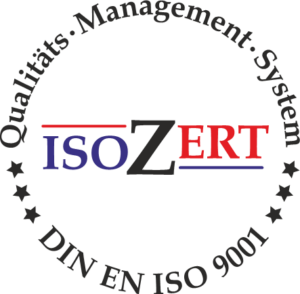5G Campus FAQs
Learn more about the key benefits of a 5G campus network.
What is 5G?
5G is the fifth generation of wireless network technology. Core features of a 5G network are the delivery of higher data speeds, reduced latency, support for more users and devices, and optimization of network efficiency and security. It is up to 20 times faster than 4G LTE, can support up to 100 times more connected devices, and provides ultra-low latency of up to 1 millisecond. 5G campus networks are the perfect solution for applications whose requirements cannot be met by existing (WLAN) networks.
What is a 5G campus network?
A 5G campus network is a spatially delimited private mobile communications network that can be set up independently of the public mobile communications network and ensures high-performance quality of service (QoS) (see the properties listed above under “What is 5G”). The frequency range 3.7 – 3.8 GHz is intended for 5G campus networks; here, the full 100 MHz bandwidth or parts of it can be applied for in 10-MHz increments.
The frequencies are allocated by the Federal Network Agency for a defined area (property or building). In the process, the need from the application side to implement enterprise digitization must be demonstrated. Once the frequency has been allocated, use must commence within 12 months.
When does a 5G stand-alone campus network make sense?
A stand-alone network is used to set up an individual, privately usable mobile communications network with its own network ID and strict separation from the public mobile communications network by means of separate hardware and software as well as different radio bands. Interference with external users is avoided by central allocation by the Federal Network Agency, thus ensuring a high level of data security.
A stand-alone network is recommended if a high communications workload with many systems, very high demands on the reliability and availability of communications services, and long-term operation are to be expected. The operating costs are constant and can be more favorable than using public networks if the communication volume is high. As an operator, you have full access to all management functions.
What does Open-Ran mean?
Open RAN stands for Open Radio Access Network. A software-defined approach (SDR) and definitions for open interfaces create networks that are independent of proprietary technology. For example, components such as baseband units (BBU) and remote radio heads (RRH) are divided into centralized units (CU), distributed units (DU) and radio units (RU). This enables the overlapping deployment of white-box hardware and software solutions from different vendors. With Open RAN, the new disaggregated functions can also be virtualized or containerized.
How is 5G standard defined?
Like LTE, 5G is also undergoing continuous development. Version 5G Standalone 15, published in mid-2018, is considered the first full-fledged 5G standard. In June 2020, Release 16 was published by the 3GPP (3rd Generation Partnership Project), which, as of 2022, represents the basis for the currently implemented campus networks.
Features of Release 16 include:
- Latency improvements for “enhanced ultra low latency communication” (including capability for full replacement of cable-based Ethernet in factories)
- optimized V2X support per 5G, Local Area Network support for 5G
- 5G NR in unlicensed spectrum
- cell-based IoT support and evolution
- better 5G based positioning
- lower power consumption, improved MIMO
- Optimization for 5G NR deployment in unlicensed bands
- improved network slicing
What requirements does the connection to the outside need?
The connection of the 5G campus network to the outside (e.g., to the 5G core of the Mobile Network Operator [MNO]) as well as to local systems or application servers must support QoS mechanisms to ensure that the desired dimensioning/redundancy as well as the preservation of the network properties (low latencies, high throughputs, high availability, high security) are still guaranteed.
For network management of 5G campus networks, the aspects of fault, configuration, accounting, performance and security (FCAPS) management have to be considered. The specific (mobile) challenges and the protocols to be applied are new.
What does edge computing mean?
Data processing, storage and network resources are collected where they are generated with edge computing. This brings critical enterprise applications closer to data sources such as IoT devices or local edge servers. Data is provisioned, managed and hosted within the customer’s premises, such as the corporate building or factory floors. Since the data does not have to be transferred over a network to a cloud or data center, the performance of the network is increased.
What does Network Slicing mean?
Slicing” means that there is no longer “the” network, but virtualized parts of it, each with specific properties, such as a guaranteed transmission rate or a minimum response time (latency). Different applications therefore receive (only) the resources they need. Network slicing thus enables the establishment of mutually autonomous and separate virtual networks for specific customer groups, services or market segments (e.g., IoT). This ensures that costs, efficiency and flexibility can be freely addressed.
BSFZ-Siegel
Zertifizierung DIN EN ISO 9001

Zertifizierung ISO/IEC 27001

ituma GmbH
Kleinhülsen 29
40721 Hilden
GERMANY
P: +49 (0) 2103 28099 0
F: +49 (0) 2103 28099 29
E: contact (at) ituma.eu
Consultancy & Sales
sales (at) ituma.eu
PR & Marketing
marketing (at) ituma.eu
Navigation
- 5G Campus FAQ
- 5G Campus Netz Kleinhülsen
- 5G Innovation für die Zukunft
- aduno campus
- aduno Cloud für Systemintegratoren eng
- aduno ÖPNV Cloud für Systemintegratoren eng
- aduno Verticals
- aduno Verticals Banken
- aduno Verticals Healthcare
- aduno Verticals Hotels
- aduno Verticals Retail & Malls
- aduno Verticals Städte und Gemeinden
- aduno WLAN Carrier-Grade
- aduno WLAN Detail Features
- API Integration
- Contact
- DB Case Study
- Home
- Imprint
- Jobs
- MDU SOLUTION
- News 02
- ÖPNV Solution
- Partner
- Privacy Policy
